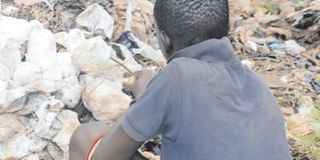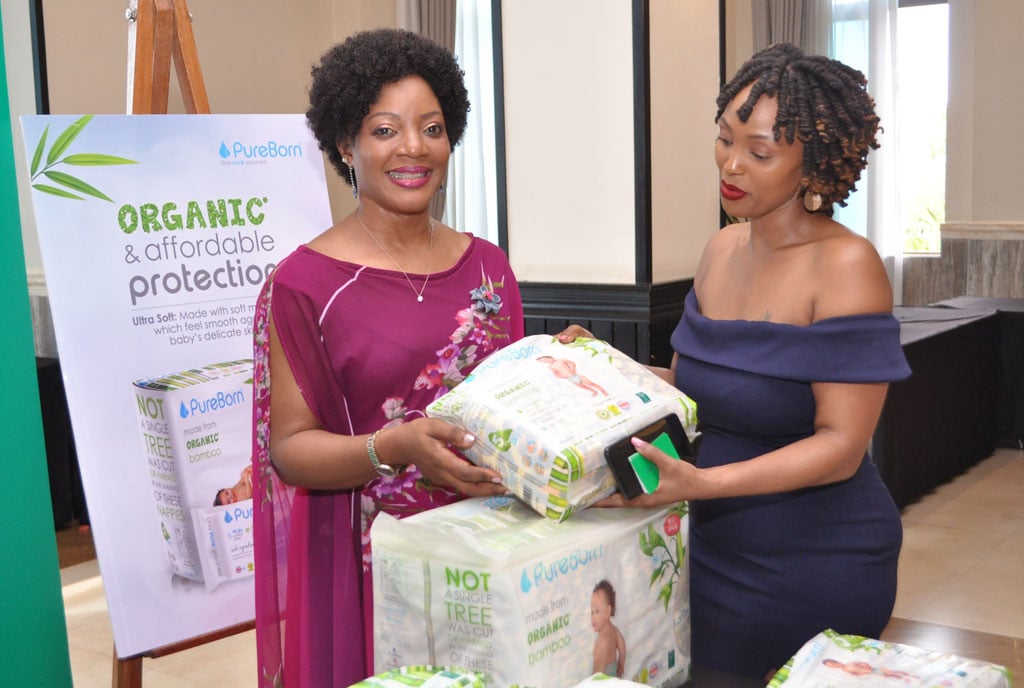Prime
Disposable diapers: Cheap, handy but toxic

A boy at Masese Landfill in Jinja City where single-use diapers are dumped. PHOTO/ABUBAKER KIRUNDA
What you need to know:
- Dr Ronald Katwaza, the product development officer at the National Agricultural Research Organisation (Naro), says the organisation has started manufacturing biodegradable and compostable sanitary pads and diapers.
- While reusable diapers are clear alternatives to single-use nappies, they require a lot of water and energy for washing. Dr Turyasiima says while cloth diapers are good for the environment, they may have a huge effect on the baby if the caregiver does not have a proper hygiene routine.
Data from the World Economic Forum shows that in 2023, more than 300,000 disposable diapers were sent to landfills or incinerated every minute, globally. The single-use nappies, made of plastics, wood pulp viscose rayon and cotton, are one of the biggest contributors to plastic waste, creating a huge problem for the environment.
Since their introduction into the Ugandan market more than 20 years ago, disposable diapers have proved to be cheap and convenient, saving many mothers in today’s busy labour market from the repetitive chore of washing cloth nappies. Single-use diapers cost between Shs500 to Shs1000 each, making them affordable to low-income earners.
A March 2021 report, single-use nappies and their alternatives, by the United Nations Environment Programme (UNEP) indicated that in that year, the booming global nappy market was expected to exceed $4,711 billion by 2022.
“The growth is being fuelled by high birth rates in developing countries, coupled with improving economies and urbanisation, along with increased availability and marketing, amongst other factors,” the report says.
Musa Kabugo, a retail shop owner on Aldina Road in Jinja City, says he is aware of the dangers diapers pose to the environment, but he earns so much from them that he cannot stop selling them.
“Diapers are in high demand, especially in urban areas which are full of working mothers. A woman can purchase two in a day. I make a profit of Shs200 from each diaper I sell at Shs1,000. Unfortunately, after using them, the women just dump them anywhere,” he says.
The fine for littering is Shs100,000 in the city, although several people get away with the vice due to lack of enforcement.
Dr Munanura Turyasiima, a consultant paediatrician at Kampala International University Teaching Hospital, says single-use diapers can cause candidiasis in a baby.
“Too much urine keeps the single-use diaper wet over long periods. The diaper then becomes home to infections of the urinary tract, candidiasis, irritation and diaper dermatitis. Candida grows in warm, moist places, meaning the candida diaper rash is more likely to infect babies who are not kept clean and dry,’’ he says.
At the source of the River Nile, where Brenda Kisakye runs the John Speke canteen, each disposable diaper is sold at Shs3,000.
“The tourists who come to the Source of the Nile with toddlers have no option but to buy my diapers. We make high profits from the sales but fortunately, the tourism site has dustbins strategically placed in all corners to collect the diapers. The used diapers are taken to a site gazetted by city authorities,” she says.
Managing problems
According to the UNEP report, plastic pollution is reaching crisis proportions as the world’s production and consumption of single-use plastic products far outstrips its capacity to dispose of these items safely. In the past few decades, plastic production soared from two million metric tonnes in 1950 to 348 million metric tonnes in 2017.
“About 60 percent of this is estimated to have ended up in landfills, or oceans and waterways. In urban environments, particularly in low-income countries where as much as 93 percent of waste is openly dumped, plastic waste causes flooding and waterborne diseases by clogging drains and respiratory diseases by releasing toxins and particulates when burnt,” the report indicated.
However, even with the poor waste management infrastructure in the country, people are more aware now of the environmental impact of disposable diapers and the risks involved when the government does not enact policies on waste disposal.
Since they are made from plastic, the diapers, even those disposed of at landfills or in pit latrines, do not decompose, thus emitting methane and other greenhouse gases.

Washable diapers can save the environment.
Fazira Kawuma, the deputy mayor of Jinja City, urges that sanitary waste must be sorted at the source.
“I call on residents to separate their waste. Things such as plastic bottles, as well as sanitary and kitchen waste should be put in separate sacks before the waste management company visits the home. This will facilitate easy recycling and also protect the environment,” she says.
Samalie Thabo, the executive director of Pure Earth Organisation, which advocates for a clean environment, says poorly disposed diapers have now become a source of floods in some areas.
“One of the main reasons we saw floods in Kawempe and Bata Bata on Entebbe Road was because the drainage channels were clogged with plastics, which included used diapers. The insolvent nature of these diapers means that even if they are dumped on soil, they block the flow of water in the soil, yet agriculture needs fertile soil,” she says.
Most plastic does not degrade, but over time, it breaks down into smaller pieces that eventually become microplastics. These tiny plastics can flow almost undetected in water and are now finding their way into the food chain.
Thabo advocates for the establishment of incinerators in different areas where caregivers can throw used diapers. However, Jinja City does not have a public incinerator, according to Ernest Nabihamba, the city’s natural resources officer.
“Every city and municipality must have a public incinerator to cater for sanitary waste. Health regulations dictate that all hospitals and health centres must have incinerators, but these are specific to hospital waste. Jinja Regional Referral Hospital has an incinerator but the other health centres do not,” he says.
Depending on the size, the smallest incinerator can cost between Shs100m and Shs200m. The UNEP report assesses three end-of-life options for a standard single-use nappy with a mixture of urine and faeces.
“Recycling single-use nappies has negative impacts owing to the recovery of plastics and the avoidance of emissions. Co-incineration also shows negative impacts related to the production of electricity, carcinogens, global warming potential and non-renewable energy use,” the report says.
Reusable diapers to the rescue
Dr Ronald Katwaza, the product development officer at the National Agricultural Research Organisation (Naro), says the organisation has started manufacturing biodegradable and compostable sanitary pads and diapers.
“The inner material is locally sourced from banana stem fibres after harvesting the banana crop. We have partnered with other companies that produce the outer material of the diapers and pads, which is also degradable. Our reusable diapers offer a rash and irritation-free experience because they do not contain chemicals,” he says.
Harriet Letasi, the in-charge of quality at Kijani Diapers, which makes and sells reusable bamboo/cotton cloth diapers, says their diapers are environmentally friendly.
“All one needs to do is wash and dry them. Each reusable diaper costs Shs34,000 but it can be used for up to two years. This is cost-effective compared to buying two disposable diapers per day at the cost of Shs1,000 each.
While reusable diapers are clear alternatives to single-use nappies, they require a lot of water and energy for washing. Dr Turyasiima says while cloth diapers are good for the environment, they may have a huge effect on the baby if the caregiver does not have a proper hygiene routine.
“It is not easy to remove all the dirt (urine and stool), especially if the caregiver has only a few diapers to use because of the exorbitant initial cost. Some of them do not dry well, especially in the rainy season. Single-use diapers will remain the better choice for the baby’s hygiene unless the gaps in handling reusable ones hygienically are addressed,” he says.
For the health of the baby and the environment, Dr Turyasiima encourages mothers not to use diapers for 24 hours, but to alternate. One can use diapers when taking the baby out of the home, but at home, the baby can be diaper-free.
While single-use nappies are cheap and convenient, they call for policies that will put waste management technologies and infrastructure in place. The environmental impacts of these nappies fall largely in the hands of the manufacturers, in terms of product design, and the municipalities, in terms of waste management systems and end-of-life treatment.
What other countries are doing
In May 2019, Italy signed an ‘End of Waste’ decree that opened up the possibility of recycling and reusing the materials that make up used diapers and sanitary pads.
The Faster Smart recycling facility recycles the diapers and
transforms them into hangers, clothespins, industrial packaging, cables, building materials and new absorbent materials.
The diapers are kept in a storage tank where the worst fumes are drawn off and then filtered. The diapers are then broken apart by subjecting them into intense heat, pressure and steam and that has the effect of drawing off the stool from the nappies and the materials left behind are then shredded and then put into the oven for drying out. The idea is to kill any bacteria that might be left behind.
The next step is to separate he different materials used in nappies so that they can be sed to make plastic products.




